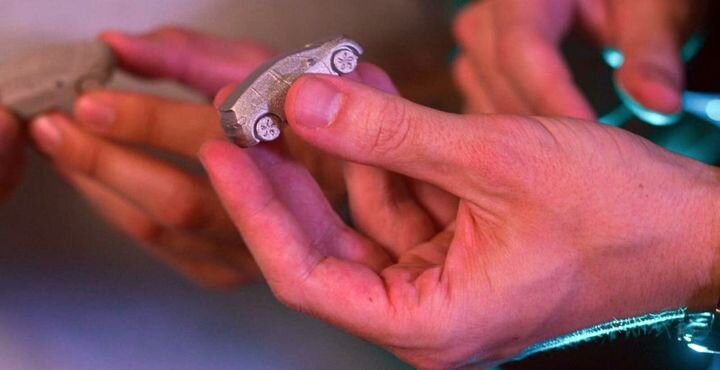![One of the 10,000 parts produced for the launch event [Source: ENGINEERING.com ]](https://fabbaloo.com/wp-content/uploads/2020/05/image-asset_img_5eb08bfecdc7e.jpg)
Last year Volkswagen selected HP Metal Jet for the high volume manufacturing of production-grade metal parts, as the foundation for its strategy to industrialize additive manufacturing with a multi-year design and production roadmap.
With a production run of more than 10,000 high quality parts produced by HP and GKN Powder Metallurgy in just a few weeks to support the ID.3 electric vehicle launch event, Volkswagen reached a key milestone in the first stage of its three-phase strategic roadmap to functional production. The 10,000 parts are small models of the vehicle.
“Our vision to industrialize additive manufacturing is quickly becoming a reality with HP Metal Jet, it is a game changer for the automotive industry,” said Dr. Martin Goede, Head of Technology Planning and Development, Volkswagen. “The pace of innovation by HP and advanced capabilities of the technology have exceeded our expectations. We are meeting our milestones and are actively identifying and developing functional parts for production.”
Dr. Goede expanded on the important milestone, and the work Volkswagen and HP are doing together on the path to mass production, in this video.
The production of the ID.3 models represents the successful execution of the first step of Volkswagen’s strategic roadmap for metal additive manufacturing production beginning with mass customization and cosmetic parts. In subsequent phases Volkswagen intends to integrate printed metal structural parts into the next generation of vehicles as quickly as possible and are targeting a continuous increase in part size and technical requirements – with the future goal of soccer-ball-size parts of 50,000 to 100,000 per year.
Examples of higher performance functional parts with significant structural requirements e.g. gearshift knobs and mirror mounts. As new platforms such as electric vehicles enter mass production, metal 3D printing is expected to be leveraged for additional applications such as the light weighting of fully safety-certified metal parts.
“A digital transformation in the auto industry is underway and Volkswagen is leading the way with strategic vision and bold action,” said Tim Weber, Global Head of Metals, HP 3D Printing and Digital Manufacturing. “We are committed to delivering the capabilities our customers need to accelerate the design and production of high quality final parts with breakthrough economics. Together with Volkswagen and partners like GKN we are standing up the factories of the future.”
HP is partnering with GKN Powder Metallurgy, a provider of metal parts, to deploy HP Metal Jet factories to produce functional metal parts for auto and industrial companies. The collaboration between Volkswagen, HP and GKN Powder Metallurgy has resulted in the ability to move quickly to produce parts at scale.
To support the recent unveil of the new Volkswagen ID.3, which the automaker claims is the first fully electric production car with a CO2-neutral footprint, the company leveraged the rapid expansion of Metal Jet capacity at the GKN Factories in Bad Langensalza and Radevormwald and at HP in Barcelona to produce more than 10,000 ID.3 models for the vehicle‘s massive marketing campaign. Volkswagen intends to distribute the models to Volkswagen employees and car dealers around the world.
In the continuing development of additive manufacturing, especially in metals, the applications in real manufacturing have been something of an open question, especially in high-volume industries such as automotive. This move by Volkswagen signals that additive manufacturing is making inroads into functional production as a real, viable manufacturing technology.
Read more at ENGINEERING.com

